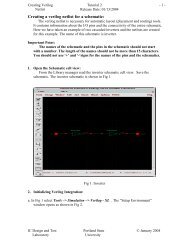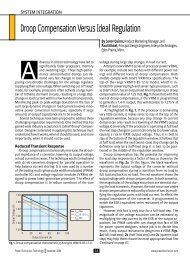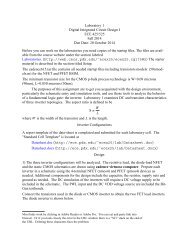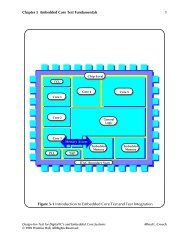LTspice IV Steady State AC Analysis
LTspice IV Steady State AC Analysis
LTspice IV Steady State AC Analysis
Create successful ePaper yourself
Turn your PDF publications into a flip-book with our unique Google optimized e-Paper software.
<strong>LTspice</strong> <strong>IV</strong> <strong>Steady</strong> <strong>State</strong> <strong>AC</strong> <strong>Analysis</strong><br />
University of Evansville<br />
July 27, 2009<br />
In addition to <strong>LTspice</strong> <strong>IV</strong>, this tutorial assumes that you have installed the University of Evansville Simulation Library for<br />
<strong>LTspice</strong> <strong>IV</strong>. This library extends <strong>LTspice</strong> <strong>IV</strong> by adding symbols and models that make it easier for students with no<br />
previous SPICE experience to get started with <strong>LTspice</strong> <strong>IV</strong>.<br />
An Example Circuit<br />
<strong>LTspice</strong> <strong>IV</strong> is capable of performing three basic types of circuit analysis. In DC Operating Point analysis capacitors are<br />
treated as open circuits, inductors are treated as short circuits and <strong>LTspice</strong> <strong>IV</strong> calculates voltages and currents that would be<br />
displayed by a DC voltmeter. In Transient analysis, <strong>LTspice</strong> <strong>IV</strong> numerically solves the differential equations that describe<br />
the circuit and shows results that are typically seen on an oscilloscope. This analysis method is <strong>LTspice</strong> <strong>IV</strong>'s most powerful<br />
(realistic) circuit simulation method. It allows non-linear devices to be modeled and is therefore useful in the analysis and<br />
design of non-linear circuits (clippers, clampers, power supplies, switching circuits, etc.)<br />
<strong>AC</strong> analysis results are only meaningful if the circuit is linear. It uses a small-signal linear model for all non-linear devices<br />
(diodes, transistors) and provides meaningless results if these devices operate in a non-linear mode in the corresponding<br />
real-world circuit. There are a tremendous number of circuits that are linear (all of the RLC circuits we've looked at this<br />
semester and transistor and op amp based amplifiers are all assumed to be linear). In <strong>AC</strong> analysis, <strong>LTspice</strong> <strong>IV</strong> does a<br />
complex phasor analysis and can therefore be used check the results of your phasor analysis homework.<br />
We will use <strong>LTspice</strong> <strong>IV</strong> to determine the currents i 1 and i 2 in the circuit shown in Figure 1. The source voltages are equal to<br />
v 1 = 10 cos(1000 t) V and v 2 = 20 cos(1000t – 30º) V.<br />
1 kΩ 1 H 1 H 1 kΩ<br />
i 1<br />
i 2<br />
1 μF<br />
v 1<br />
+ + v – – 2<br />
1 kΩ<br />
Figure 1: Example Circuit<br />
The corresponding <strong>LTspice</strong> <strong>IV</strong> schematic is shown in Figure 2. Resistors R1 and R2 are oriented in agreement with the<br />
desired current directions. (Note the small triangles near one end of a component. These define the assumed direction for<br />
positive current during the simulation.)<br />
The settings for voltage source v 1 are shown in Figure 3. Notice that the (none) function radio button tab has been selected.<br />
Any of the sources could have been selected because they have no affect on the source during <strong>AC</strong> analysis. In <strong>AC</strong> analysis<br />
only the <strong>AC</strong> Amplitude and <strong>AC</strong> Phase values have any effect on the simulation. All other values are ignored during <strong>AC</strong><br />
analysis. Note also that we do not enter in a simulation frequency at this point (that is done later). The <strong>AC</strong> magnitude and<br />
<strong>AC</strong> Phase are 10 V and 0º respectively.<br />
1 of 5
Figure 2: <strong>LTspice</strong> <strong>IV</strong> Schematic<br />
The voltage settings for v 2 look very similar except that the <strong>AC</strong> magnitude is equal to 20 and the <strong>AC</strong> Phase is equal to -30.<br />
Figure 3: Voltage Source v 1 Settings<br />
After completing the schematic and setting up the voltage sources. We are now ready to run an <strong>AC</strong> analysis. Click on the<br />
Run icon and the Edit Simulation Command dialog window will appear as shown in Figure 4. Select the <strong>AC</strong> <strong>Analysis</strong> tab.<br />
<strong>AC</strong> <strong>Analysis</strong> can be done at a single frequency or at several frequencies. We only want results at a single frequency<br />
(1000 rad/s), so select List in the pull-down menu. In the text area at the bottom of the window add “{1000/(2*pi)}” to the<br />
2 of 5
simulation command. (Note that <strong>LTspice</strong> <strong>IV</strong> expects frequencies in Hertz, not rad/sec. Now I could convert 1000 rad/s to<br />
Hertz on my calculator, but I let <strong>LTspice</strong> <strong>IV</strong> do the calculation for me. As we have seen in previous tutorials, the expression<br />
must be entered in curly braces.) After clicking on the OK button the simulation will proceed. A window similar to that<br />
shown in Figure 5 should appear.<br />
Figure 4: <strong>AC</strong> <strong>Analysis</strong> Simulation Command<br />
From Figure 5 we see that the I 1 phasor is equal to (6.735 mA ∠38.5º) at 1000 rad/s while that of I 2 is equal to (5.946 mA<br />
∠131.3º) These phasor values correspond to steady-state time-domain currents of:<br />
i 1 = 6.735 cos(1000 t + 38.5º) mA<br />
i 2 = 5.946 cos(1000 t + 131.3º) mA<br />
Note that both phase angles are positive, so both currents lead voltage source v 1 .<br />
Phasor Domain Circuits<br />
You can use <strong>LTspice</strong> <strong>IV</strong> and <strong>AC</strong> analysis to obtain results for phasor domain circuits. Just set up the simulation at a<br />
frequency of ω = 1 rad/s (f = 1/(2π) Hz). For an inductor with an impedance of jX use an inductance value of L = X in the<br />
simulation. For a capacitor with an impedance of -jX use a capacitance value of C = 1/X. (Let <strong>LTspice</strong> <strong>IV</strong> do the math just<br />
enclose the expression in curly braces).<br />
For example to obtain V o in the phasor domain circuit shown in Figure 6, we use the <strong>LTspice</strong> <strong>IV</strong> schematic shown in Figure<br />
7. At 1 rad/s (or 1/(2π) Hz), the components shown in the <strong>LTspice</strong> <strong>IV</strong> schematic will have exactly the same impedance as<br />
the corresponding component in the phasor domain circuit. Results from simulating at a frequency of 1/(2π) Hz are shown<br />
in Figure 8. The results indicate that V o is (11.314 V ∠-45º). Manual phasor domain analysis of the original circuit yields a<br />
result of (11.314 V ∠-45º) in exact agreement with <strong>LTspice</strong> <strong>IV</strong>. (The <strong>LTspice</strong> <strong>IV</strong> simulation was much faster than manual<br />
analysis!!)<br />
3 of 5
Figure 5: <strong>AC</strong> <strong>Analysis</strong> Simulation Results<br />
j70 Ω<br />
-j400 Ω<br />
72 V ∠0º<br />
50 Ω<br />
590 I X<br />
I X<br />
160 Ω<br />
+<br />
V O<br />
-<br />
Figure 6: Phasor Domain Circuit<br />
Tips<br />
You may have noticed that you can do the <strong>AC</strong> analysis at multiple frequencies. If you perform the <strong>AC</strong> analysis at more than<br />
one frequency the Waveform Viewer will be opened and you then probe the circuit to display node voltages and device<br />
currents as a function of frequency. This a very useful feature and will be the subject of the next tutorial.<br />
4 of 5
--- <strong>AC</strong> <strong>Analysis</strong> ---<br />
(a)<br />
(b)<br />
Figure 7: <strong>LTspice</strong> <strong>IV</strong> Schematic Corresponding to Figure 6<br />
Note the inductance and capacitance values used in the schematic.<br />
frequency: 0.159155 Hz<br />
V(n002): mag: 30.4629 phase: -113.198° voltage<br />
V(n003): mag: 41.7191 phase: 135.001° voltage<br />
V(vo): mag: 11.3136 phase: -44.999° voltage<br />
V(n004): mag: 30.4629 phase: -113.198° voltage<br />
V(n001): mag: 72 phase: 0° voltage<br />
I(C1): mag: 0.0707103 phase: 135.001° device_current<br />
I(L1): mag: 1.2649 phase: -71.5641° device_current<br />
I(R2): mag: 0.0707103 phase: -44.999° device_current<br />
I(R1): mag: 1.20207 phase: -73.0715° device_current<br />
I(V1): mag: 1.2649 phase: 108.436° device_current<br />
Ix(u1:V+): mag: 1.20207 phase: -73.0715° subckt_current<br />
Ix(u1:V-): mag: 1.20207 phase: 106.928° subckt_current<br />
Ix(u1:ISAMPLE+): mag: 0.0707103 phase: 135.001° subckt_current<br />
Ix(u1:ISAMPLE-): mag: 0.0707103 phase: -44.999° subckt_current<br />
Figure 8: Results from Simulation of the Circuit in Figure 7<br />
5 of 5


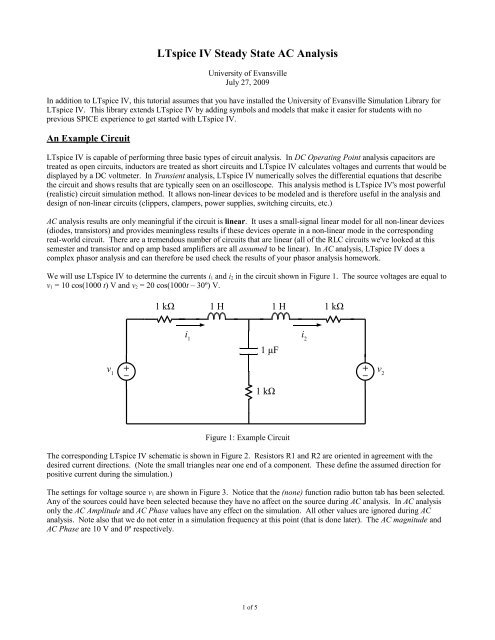
![Examples (Node/Mesh) [PDF] - Electrical & Computer Engineering](https://img.yumpu.com/51120793/1/190x253/examples-node-mesh-pdf-electrical-computer-engineering.jpg?quality=85)

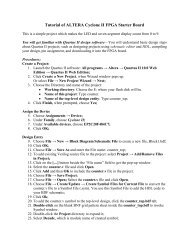
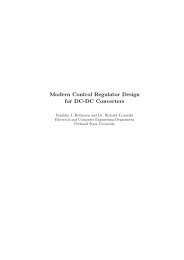
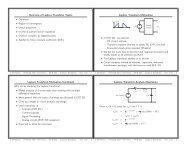
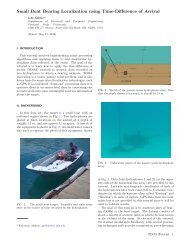
![Cuk converter transfer function derivation [PDF]](https://img.yumpu.com/38542022/1/190x245/cuk-converter-transfer-function-derivation-pdf.jpg?quality=85)
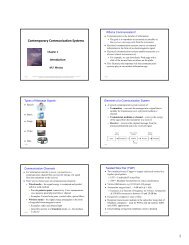
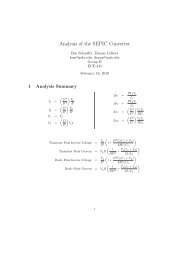
![Cuk converter design report done in Latex [PDF]](https://img.yumpu.com/38541847/1/190x245/cuk-converter-design-report-done-in-latex-pdf.jpg?quality=85)
